Tour of Tête Noire and Lac de la Partie
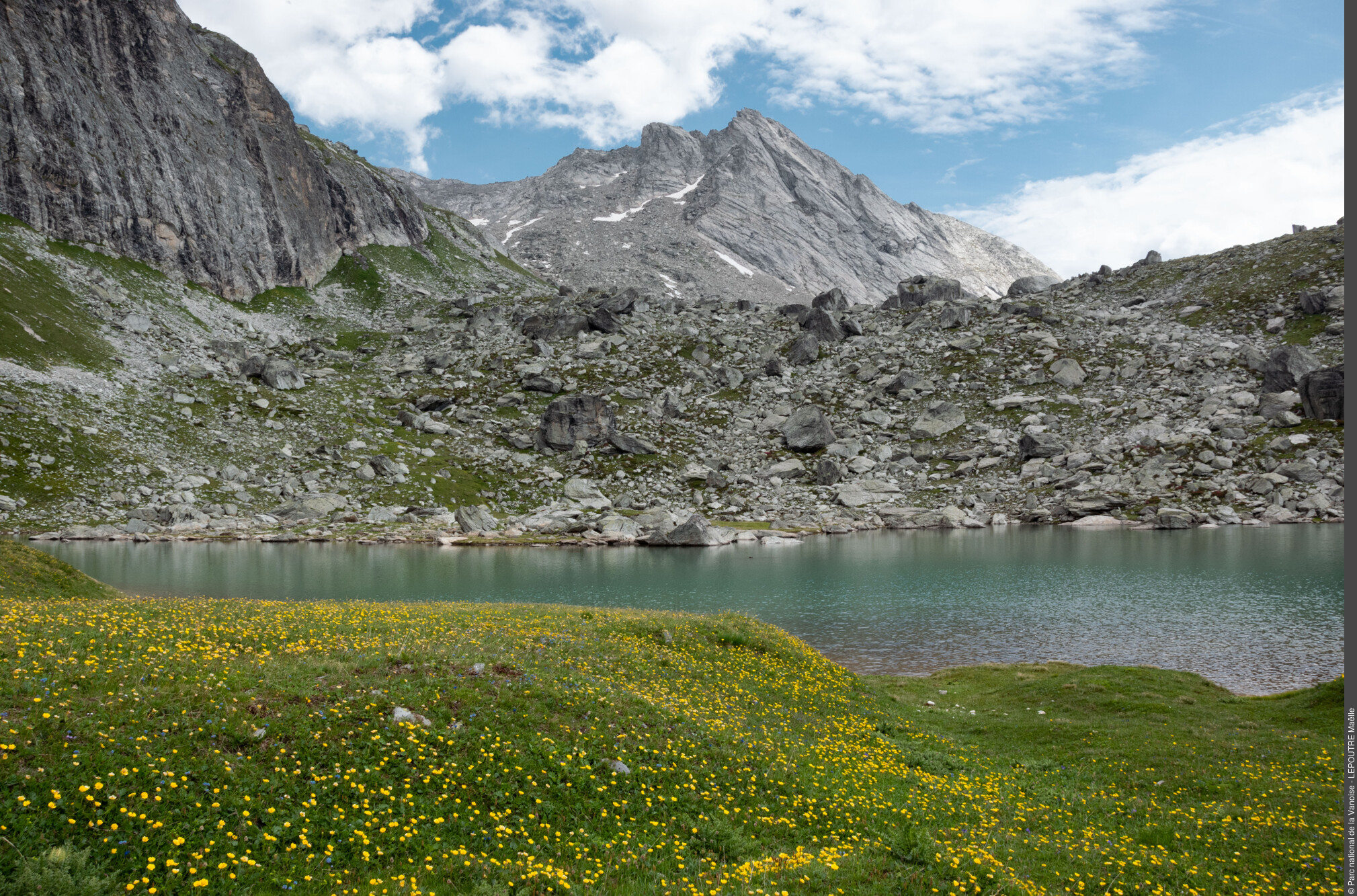
VILLARODIN-BOURGET
Tour of Tête Noire and Lac de la Partie
Challenging
8h30
12,9km
+851m
-852m
Loop
Embed this item to access it offline
It is with some regret that we leave the captivating and serene Orgère valley, but you will be even more amazed by its splendour as you climb up the valley. Ÿou will quickly find yourself immersed in the surrounding summits, the view of the Chavière glaciers and the discovery of Lac de la Partie, nestled at the foot of the Aiguille Doran. Dazzled by the different perspectives, you will slowly descend to the hamlet of Polset, before taking advantage of a shady path that gently leads you back to Orgère.
Description
"From Orgère car park, go down the road to the refuge and take the trail on your right signposted by the Park. Climb through a wooded combe to reach the ruins of Estiva. Continue north via a gentler terraced path. Arrive at a recently restored calade and follow this gently sloping paved trail. Arrive once again at a quieter relief, cross an area of scree before reaching a crossroads. On your right, below is Lac de la Partie. To go back down, reach this crossing and follow the signs for ""Hameau de Polset"". Once at the hamlet, cross it following a track, then before the track makes a first turn, take the route for Refuge de l’Orgère. Enter the forest before crossing a road and continue to follow the sign marked ""l´Orgére"" for the return."
- Departure : Orgère car park, Villarodin-Bourget
- Arrival : Orgère car park, Villarodin-Bourget
- Towns crossed : VILLARODIN-BOURGET and MODANE
Forecast
Altimetric profile
Recommandations
Is in the midst of the park
The national park is an unrestricted natural area but subjected to regulations which must be known by all visitors.
Information desks
Maison Cantonale, 9 Place Sommeiller, 73500 Modane
Transport
"Rail connection to Modane. Information: www.voyages-sncf.com
No public transport between Modane and Orgère car park.
Suggested hitchhiking organised in the Haute-Maurienne valley. Information: www.rezopouce.fr"
No public transport between Modane and Orgère car park.
Suggested hitchhiking organised in the Haute-Maurienne valley. Information: www.rezopouce.fr"
Access and parking
From the exit of the A43 motorway, take the direction of Modane. At the Freney roundabout, take the RD 106 towards the Refuge de l´Orgère which is signposted. After a 30 minute drive, pass the Refuge on your right to access the car park.
Parking :
Orgère car park, Villarodin-Bourget
Accessibility
Two disabled parking spaces, Refuge-Porte de l´Orgère certified “Accessible Tourism” for the 4 types of disability.
- Emergency number :
- 114
More information
10 points of interest

Chalet en ruine à l'Estiva. Vue vers Modane (en bas), l'Aiguille de Scolette et la Norma. - PNV - PERRIER Jacques  Viewpoint
ViewpointL'Estiva
"Situated just above the forest boundary, the ruins of ""L´Estiva"", testament of former pastoral activity, offer a breathtaking view of the whole valley of Maurienne and the valley of l’Orgère."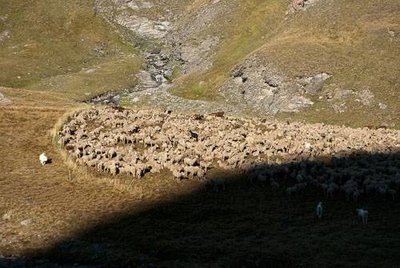
Troupeau de moutons et de chèvres au parc de nuit avec leurs chiens de protection. - PNV - BEURIER Mathieu  Pastoralism
PastoralismSheep on the summer pastures
During the summer grazing period you will be able to see the sheep on the alpine pastures. This ancient pastoralism, evident in the stone ruins still standing in Estiva, still continues today. These flocks of sheep, reared by farmers in the valley, gradually climb from the village of Villarodin-Bourget by following the evolution of the growing grass.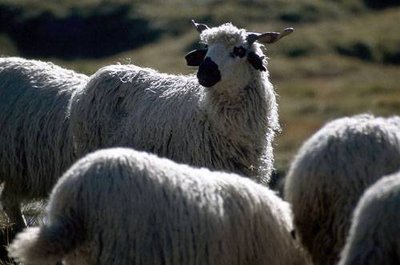
Brebis de race Thônes et Marthod. - PNV - TISSOT Nathalie  Pastoralism
PastoralismThe ovine breed Thônes and Marthod
After a sharp decline, local breeding began to recover at the end of the 20th century, thanks in particular to the Thônes and Marthod breed. This breed, with its curly wool, well-developed horns in both sexes and the black outlined eyes and ears, is easy to recognise. This sheep is remarkably adapted to the alpine pastures of southern Savoy. Although its origins are ancient, it dœs not seem to have spread from its original pre-alpine birthplace. Its hardiness, its excellent fertility and its good milking aptitude undoubtedly explain this renewed interest.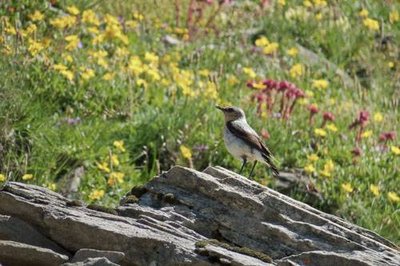
Traquet motteux : mâle en alerte, à proximité d'un juvénile. - PNV - POULET Laetitia  Fauna
FaunaThe wheatear
A small sparrow characteristic of the alpine grasslands, the northern wheatear is easy to recognise by its white rump and its tail with an inverted black T. The rest of the male’s plumage is grey, white and ochre, while the female is uniform beige. Often perched on a rock, it alerts its presence with a “wit wit” or “chac chac”. This is a migratory bird that only inhabits the Vanoise during the summer months before crossing the Sahara to spend the winter in Equatorial Africa.
Travaux de création d'un sentier en calade entre l'Estiva et le Lac de la Partie - PNV - BEURIER Mathieu  Know-how
Know-howThe calade made with the Lycée Professionnel des Métiers de la Montagne.
This portion of the trail, whose work was completed in 2013, is the fruit of a valuable collaboration between the Park workers and the “Lycée professionnel des métiers de la montagne” (vocational school of mountain trades) of Saint-Michel-de-Maurienne. For three years, the pupils of this school, supervised by the workers, used the ancestral techniques of the calade to refurbish a portion of the trail that the particularly unstable terrain was damaging each year.
Lac de la Partie. - PNV - FOLLIET Patrick  Lake
LakeLac de la Partie
Small shallow lake with glints of green at altitude, the Lac de la Partie undoubtedly originates in the rocky mounds which dominate to the south. This old rockslide has blocked the stream that flows in the base of the valley and still feeds the lake.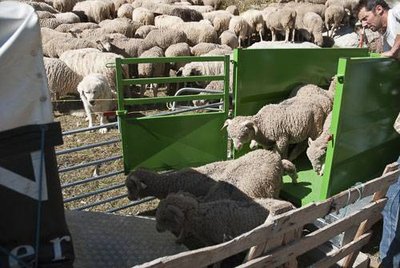
Brebis dans un pèse-bétail. - PNV - BEURIER Mathieu  Pastoralism
PastoralismTranshumance
In summer, this part of the valley is occupied by a herd of more than 1,000 merino sheep. Unlike the herds that inhabit the valley of Orgère and Estiva, this herd spends the winter on the pastures of Crau in the Bouches-du-Rhône and it is only from June that it returns to the Alps and gradually climbs from the hamlet of Polset to graze on the alpine pastures.
Reposoir à bestiaux couvert de rumex autour des Chalets de la Plagne. - PNV - AUGE Vincent  Pastoralism
PastoralismThe cattle rests
"Called ""cattle rests"", these grounds where the herds are stationed are greatly enriched with nitrates by the animal excrement. Often located near a shepherd´s hut, they have a dense, exuberant and sparsely varied vegetation, composed mainly of alpine docks. This nitrophilous plant (which likes nitrate) is also called ""monk’s rhubarb""."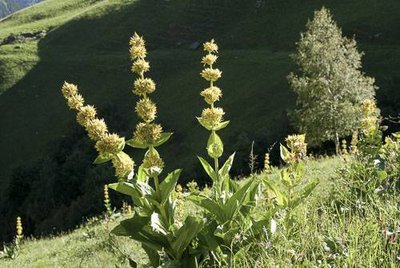
Grande gentiane jaune. - PNV - BALAIS Christian  Flora
FloraThe great yellow gentian
Among the gentian species, the great yellow gentian is the most used: its roots have tonic, digestive and cleansing properties. Abandoned by cows for its bitterness, it was traditionally picked at the end of September. It should not be confused with the white hellebore (Veratrum album) which is similar in appearance before flowering but very toxic. Distinguishing between the two is easy: the leaves of the gentian are positioned in an opposing way while the veratrum album alternate in spirals. The gentian grows abundantly in the highland pastures.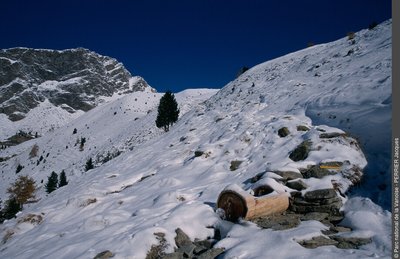
Bachal près de la Source du Vin - Jacques PERRIER  Water
WaterThe Source du Vin (source of wine)
This small spring, which obviously dœs not produce wine, was set up by the workers of the National Park to offer a welcome pit stop on this very sunny route. The origin of the name of this place is not really known, but the most sensible explanation would be to say that it is a place where one could drink wine without restraint!
